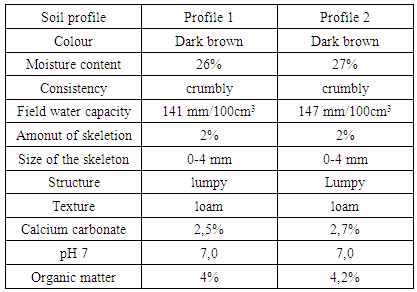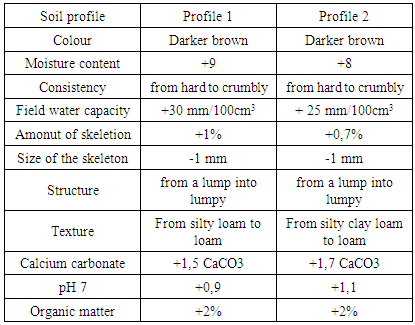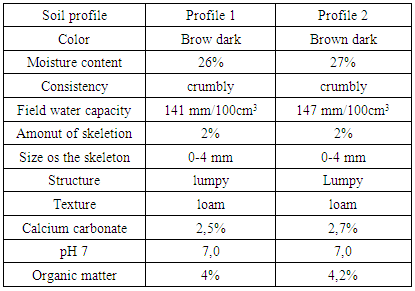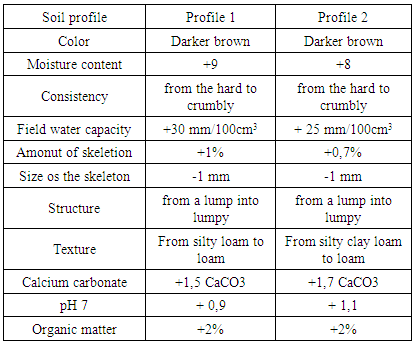Ana Vovk Korže
University of Maribor, Faculty of Arts, International Centre for Eco remediation, Maribor, Slovenia
Correspondence to: Ana Vovk Korže, University of Maribor, Faculty of Arts, International Centre for Eco remediation, Maribor, Slovenia.
| Email: |  |
Copyright © 2018 The Author(s). Published by Scientific & Academic Publishing.
This work is licensed under the Creative Commons Attribution International License (CC BY).
http://creativecommons.org/licenses/by/4.0/

Abstract
Permaculture is a complex approach which connects environmental, social and economic aspects. Due to its innovative approaches and natural appearance, it is interesting for people of all ages, including the young and there is a growing need to deploy permaculture in practise. Permaculture means new opportunities for soil protection and saving natural resources and ensuring greater self-sufficiency. Improvement of the physical properties of the soil after two years of use permacultural approach shows the benefits brought by this kind of care for the soil. The great importance of organic matter in the soil, it is also important that permacultural approaches adapt to climate change. We illustrate the points with reference to the Dole site in Dravinja valley in Slovenia.
Keywords:
Permaculture, Climate changes adaption, Natural resources, Educational polygon Dole
Cite this paper: Ana Vovk Korže, Permaculture for Sustainable Life Style, International Journal of Inspiration & Resilience Economy, Vol. 2 No. 2, 2018, pp. 34-39. doi: 10.5923/j.ijire.20180202.02.
1. Introduction
Permanent Agriculture (Permaculture) is an ecological innovation, which develops sustainable human settlements in both villages and cities in which settlement intensity is considerably high. Green roofs and green terraces are good examples of permaculture in urban areas. Permaculture is a combination of interdisciplinary practices, including agriculture, water harvesting, hydrology, energy, natural building, forestry, waste management, smart solutions for land use, aquaculture and green technologies. Since it includes a wide scale of innovative green activities, permaculture is the main focus of this research work. It is increasingly recognized that only industrial production and processing of food and the globalized approaches are not the ways to provide healthy food and water as well as the required standard for all people. Therefore, the necessary initiatives at the local level were established to promote sustainable modes of food production and life, to create new jobs and many services and activities at the local level. Food security is the basis of survival of mankind (Raman, 2006), it is therefore a key challenge for any economy sustainable provision of adequate quantity and quality of food for the population. Although agriculture is the need we should take into the account of the natural capacity for food production (Pierce, 1990), are the main natural sources fertile soil and water quality. Natural soil fertility reduces the degradation processes such as erosion, flooding, drought and disease. The strategy of providing food safety for each country includes sustainable self-sufficiency by the use of domestic that is locally grown and processed products. Merely that creates jobs, innovative occupations, motivate people for sustainable technologies and reduce energy consumption (less mobility, use of local resources) and, most importantly, increases the value of the subsistence country and allows the employability of people.Large youth unemployment in Europe demand search for new work opportunities especially for young people. Permaculture as a complex approach connects environmental, social and economic aspects. Due to the innovative approaches and natural appearance is interesting for both; the young and the elderly. Therefore, permaculture means a new opportunity for work for the younger generation who will have to deal with saving natural resources and ensure a higher degree of self-sufficiency. Permaculture is an ecological design system for sustainability in all aspects of human endeavor. It teaches us how to design natural homes and abundant food production systems, regenerate degraded landscapes and ecosystems, develop ethical economies and communities, and much more. As an ecological design system, permaculture focuses on the interconnections between things more than individual parts (Permaculture institute, 2013). Permaculture is much more than a land-use planning, the combination of stocking and food production, water supply, energy, waste water treatment with ecoremediation and cohabitation with animals (Whitefield, 2012). Permaculture is an increasingly popular trend around the world and, whether they achieve it fully or not, many gardeners aspire to its basic principles. Permaculture is all about design; it is a way of creating everything from abundant and self-sustaining homes and gardens to truly meaningful community projects (Permaculutre Free Presse).Soil is a scare resource. Therefore, soil should be used with care in a its qualities need to be preserved. Since soil protection is not comprehensively regulated in most EU countries. Need for soil protection is the mail goal of Soil Strategy 2016. The Soil Strategy points out the soil is a characcteristics element of nature and landscape and an integral part of ecological balance, especially with regards to the water and nutrient cycles. One of the central objectives is the sustainble preservation of the soil since it is a vital resource, a living environment for humans, animals and plants and a genetic reservoir. The word permaculture or "permanent agriculture" is known as "sustainable farming", i.e. management in harmony with nature, which is based on the natural cycle and ecosystems (Hemenway, 2009). Permaculture is the conscious design and maintenance of agricultural productive systems which have the diversity, stability and resilience of natural ecosystems (Praterious, 2006). Permaculture varies from other soil management practices according to the conscious use of patterns and ideas that have been observed in nature and do not require large inputs. Permaculture can be understood as an art of the possible. It means, we use as many natural materials and things that nature offers us in itself. The aim of permaculture is to create an ecosystem environment that is self-sustaining. The systems of permaculture must maintain itself as far as possible, meaning that it does not need a continuous introduction of foreign energy to operate. When the system is up, the man stays out as little as possible, since such systems then work on their own Csete and Horvath, 2012).The knowledge of permaculture principles can significantly improve the state of the soil at the local and global level, so it is essential that these skills be included in education. The functions of the soil have to be guaranteed and reserved or restored also for the economic uses, as it practically harbours all forms of human activities, including human settlement, farming or transport. The prevention principle must ensure the functionality of soil to future generations. In this sense, in case of risk of serious and sustained damage, it is also necessary for protection to be given priority over utilisation. Permaculture is offered as a solution (Soil - a key resource for the EU, 2010).According to FAO (FAO, 2007) we could require current food production until 2050 increased by 50%, whereas it is not enough of additional arable land at the disposal, it is necessary to deal with the land extremely carefully and efficient production approaches must be used by permaculture (permanent culture, the way of food production with special care for the earth and water) and ecoremediation (taking into account of natural processes in nature). In the middle of the 21st century there will be about 10 billion people in the world for whose current eating habits we do not have enough fertile land and, consequently food (European Climate Adaptation and European Climate Adaptation Platform). Vegetarian food habits require between 700 and 800 m2 of cultivated land per person, meat-and-dairy food habits is 4000 m2 (Ellis and Mellor, 1995). In Slovenia we have 858 m2 of cultivated land per capital, the lowest across the EU (the EU average was 2080 m2) (Plut, 2012). All this forces us to think about getting a land where we could grow food, regardless of land ownership (even those who have no agricultural land and live in cities). Passive people’s attitude to a situation of self-sufficiency can mean even greater deterioration of the situation, for which we are all responsible. Therefore it is to increase self-sufficiency to put great responsibility in education that can bring closer this content to everyone (from kindergarten to lifelong learning) and to incorporate it into everyday learning. Self-sufficiency is extremely wide, and is not only the domain of the agricultural profession. These are the reasons why we in Slovenia in the municipality of Poljčane (Picture 1) created a learning polygon for self-sufficiency based on permaculture, which can be mainly used for young people to learn about food and sustainable ways of living by the experiential method. | Picture 1. In location Poljčane is educational polygon Dole on the basis permaculture for soil protection and sustainable life style |
Permaculture systems increased self-sufficiency and in recent years established itself as an attractive approach for the production of food. Permaculture is like scientific way of an integrated design used in all areas of life. The basic permaculture ethics are care for the Earth, care for people and care for sharing of surpluses and permacultural design principles (Hemenway, 2009). The main feature of permaculture planning is the placement of things in the right place in space with respect to their relations with other elements of the system, which allows efficient use of time, energy and resources.Permaculture is an ecological design system for sustainability in all aspects of human endeavor. It teaches us how to design natural homes and abundant food production systems, regenerate degraded landscapes and ecosystems, develop ethical economies and communities, and much more. As an ecological design system, permaculture focuses on the interconnections between things more than individual parts (Farming, 2009). Permaculture is much more than a land-use planning, the combination of stocking and food production, water supply, energy, waste water treatment with ecoremediation and cohabitation with animals (Graham, 2010). Permaculture is an increasingly popular trend around the world and, whether they achieve it fully or not, many gardeners aspire to its basic principles. Permaculture is all about design; it is a way of creating everything from abundant and self-sustaining homes and gardens to truly meaningful community projects.The purpose of article is monitored the results of the use of permaculture in adapting to climate change. Monitor the retention of moisture in the soil, especially in the formation of humus horizons, increase soil fertility, and consequently the greater interest of people for self-sufficiency. Using field measurements we found that permaculture help to easily adapted to climate change.
2. Methodology
We measured the following soil properties: color, moisture, consistency, field water capacity, the amount of the skeleton, the size of the skeleton, structure, texture, calcium carbonate, pH and organic matter content. Soil analysis was carried out according to international ISO standards for soil (Standards catalogue http://www.iso.org/iso/home/store/catalogue_tc/catalogue_tc_browse.htm?commid=54328.
3. Results and Discussion
The permaculture garden Dole is located in the village of Dole in the Municipality Poljčane in Slovenia and covers 1.2 ha (Picture 2). The permaculture garden was established in 2010 and its main purposes is education of self-sufficiency, for everyone from preschool education to lifelong learning. The focus of the permaculture garden is in identifying the possibilities of using natural resources for self-sufficiency in energy, which is closely related to mathematics, geography, geomorphology, climatic geography, hydro-geography, vegetation geography and soil geography.  | Picture 2. Self-sufficiency area Educational polygon Dole in Poljčane |
Differences in soil properties before and after permaculture gardeningIncreased soil moisture content is a consequence of both rainfall, which fell a few days prior to sampling, as well as the ability of soils to trap moisture (Mahmood et al., 2004). Soils that have organic matter have a greater ability to retain moisture. Moreover, soil organic matter (SOM) interacts with the mechanical processes that occur in soil, on soil air content and associated gas exchanges. This affects the activity of micro-organisms, root respiration and soil chemical properties. Incorporation of SOM into the soils at the Dole site has changed soil consistency from hard into crumbly and without physical cultivation. Continual incorporation of SOM has also increased the number and diversity of soil fauna. SOM also plays an important role in the formation of humus, which, in turn, has favourable effects on other soil properties. SOM also decreases evaporation from the soil surface and protects plants and soils from the erosive forces of rain and wind. Loss of SOM decreases water infiltration rates, resulting in both more run-off and susceptibility to drought. SOM is an essential component of healthy soils and protects soil from degradation processes. Beneficial effects of permaculture are evident in that the increased SOM improves soil structure and root penetration. SOM also absorbs and retains water, increases water infiltration rates and decreases soil susceptibility to compaction, erosion and landslides.The results of soil properties measurements Table 1 contains data of the properties of the upper Ap horizon of the soil (in thickness of 15 cm) in 2011 at the permaculture garden in Dole. The soil for profile 1 was taken from the upper part of the permacultural garden and the soil of the profile 2 was taken from the lower part of the permacultural garden. It can be seen that the samples from the permacultural garden Dole have similar properties. The samples from the upper part of the permacultural garden have 2% less humidity, and a smaller diameter of the skeleton, the soil from the bottom of the garden has clay texture and lower pH.Table 1. Soil characteristics without permaculture use in Dravinja valley
 |
| |
|
The measured properties of two profiles from the field indicate that the soils are poor with organic matter because of occasional water retention (greyish color) and they are difficult to process because of lumpy and hard consistency structure.Table 2 shows the data after two-years of using permacultural approaches, namely, mulches and lifted perches. After taking soil samples, we found significant differences. Soils, which were covered with mulch, were friable (such as moles earth). There were no lumps and the soil was evenly moist. The soils were visibly darker in the upper of Ap horizon, because of adding dolomite sand to increase the content of carbonates. The data show that the soils are darker, containing one third of moisture, they are friable, FWC is higher, proportion of skeleton decreased, the structure is lumpy, the texture is loam with less clay and higher CaCO3, pH 7, and the organic matter content is 4.2%.Table 2. Soil characteristics with permaculture use
 |
| |
|
Comparison of soil samples from 2011 and 2013 shows a marked effect of permaculture in two years (Table 3). The darker colour of the upper horizon after two years of permaculture is the result of weathered organic material. This is extremely important for the processes that occur in the soil, as well as good water retention and a source of energy for soil micro-organisms. The transition of soil colours goes from grey to brown, and dark brown also shows that water does not stagnate in the Ap any more.Table 3. The differences in the properties of the soils
 |
| |
|
The importance of mulches for soilsMulch significantly affects soil moisture retention. Analysis showed that moisture was particularly retained in mulched raised beds. Pseudogleys soils contain higher proportions of clay in Bg horizons, which dries-out in the dry season, thus allowing penetration of warm and dry air to depth and adding to the drying of soil. The results of measurements properties of the soil In Table 4 contains data of the properties of the upper Ap horizon soil (in a thickness of 15 cm. It can be seen that the samples from a field have similar properties. The samples from the upper part of the field has 2% low humidity, and a smaller diameter of the no skeleton, the pattern on the bottom of the fields has several clay and lower pH.Table 4. Soil characteristics without permaculture use in Dravinja walley (september 2011)
 |
| |
|
The measured properties of two profiles from the field indicate that the soils are poor with organic matter to demonstrate occasional water retention (grayish color) and they are difficult to process because of the structure of lumpy and hard consistency.In table 5 there are the data after two-years of using permacultural approaches, namely, mulches and lifted perches. After taking soil samples, we found significant differences. Soils, which were covered with mulch, were friable (such as moles earth). There were no lumps and were evenly moist. They were visibly darker in the upper of Ap horizon, because of addition of dolomite sand to increase the content of carbonates were visible skeletal fragments. The data show that the soils are darker, containing one third of moisture, are friable, FWC is high, proportion of skeleton decreased, the structure is lumpy, the texture is loam with less clay and higher Ca C03, pH 7, and organic matter content of 4.2%.Table 5. Soil characteristics with permaculture use (september 2013)
 |
| |
|
Comparison of soil samples in 2011 and 2013 shows a marked effect of permaculture in two years (Table 6). The darker color of the upper horizon after two years of permaculture is the result of weathered organic material. It is extremely important in the processes that occur in the soil, as well as good water retention and a source of energy for soil micro-organisms. The transition of soil colors goes from gray to brown, and dark brown also shows that water does not stagnate in the Ap any more.Table 6. The differences in the properties of the soils
 |
| |
|
4. Conclusions
The improvement of the physical properties of the soil with the use of permacultural approach shows the benefits of this kind of soil treatment. Not only that permacultural approaches improve the organic matter in the soil but they also adapt to climate change. The most important affect that the mulch has for the soil is keeping the humidity in the upper horizons. Therefore, permaculture systems for soil treatment significantly affect the retention of moisture in soils especially under extreme climate conditions. Research has shown that permaculture is a comprehensive approach and that immediately after using it, contributes positively to adapting to climate changes. In the future, geography through permaculture will have an important contribution for local communities because of motivation and education that can lead to opening of new green jobs, particularly in rural areas. The influence of geography is in the comprehensive approach through the integration of young people and cooperation with the local community.In conclusion, permaculture has broad agri-environmental implications. Permacultural approaches have spread across Europe and are increasing local self-sufficiency. Permaculture offers an attractive approach for food production and an integrated design used in all areas of life. For the intergenerational transmission of knowledge is permaculture ideal because the older still know the consideration of natural principles, younger have interest to use this in practice. The second group is also significant potential generation of pensioners which is still active and can be as permaculture owner again actively involved in society. It is also a recognition that the content of sustainable development in primary school is compulsory, so all students have the opportunity to learn about permaculture as an approach to achieve sustainability. Here again has proved permaculture as an ideal approach for innovative practical education and a responsible attitude to natural resources, increase of self-sufficiency and as a contribution to social responsibility. With permaculture we develop green jobs, the possibility of supplementary activities in rural areas, and thus the possibility of self-employment. Since the permaculture in Slovenia starts to have lot of adherents in this area it is opening up new opportunities for young people that some have used.
References
| [1] | Csete, M. and L.Horvath. (2012). Sustainability and green development in urban plicies and strategies. Applied Ecology and enivornmental research 10(2): 185-194. |
| [2] | EEA. (2008). Impacts of Europes changing climate. Joint EEA, JRC WHO report, EEA Report No 4/2008. EEA Copenhagen, 246. |
| [3] | Ellis, S. and A.Mellor. (1995). Soils and Environment. New York, Routledge. |
| [4] | EC. (2009). Bela knjiga. Prilagajanje podnebnim spremembam: evropskemu okviru za ukrepanje naproti. Bruselj, COM(2009), SEC(2009) 386, SEC(2009) 387. |
| [5] | European Climate Adaptation Platform CLIMATE.ADAPT. http://climate- adapt.eea.europa.eu/. |
| [6] | FAO, (2007). Adaptation to climate change in agriculture, forestry and fisheries: Perspective, Framework and priorities. FAO inter-departmental working group on climate change (ftp://ftp.fao.org/docrep/fao/009/j9271e/j9271e.pdf, 11. 1. 2011) |
| [7] | Farming, F. (2009). Enhancing sustainable development through agriculture. Applying the farming first principles to mitigate and adapt to climate change (http://www.farmingfirst.org/downloads/FarmingFirst_Climate%20change_FINAL.pdf, 11. 1. 2011). |
| [8] | Graham, B. (2010). Permaculture Garden. ARA Publisher, Ljubljana. |
| [9] | Hemenway, T. (2009). Gia's Garden: a guide to home-scale permaculture. Chelsea Green Publishing, eBook 9781603582230. Pub. Date May 19, 2009. |
| [10] | Mahmood, R., Legates, D.R. and Meo, M. (2004). The role of soil water availability in potential rainfed rice productivity in Bangladesh: applications of the CERES-Rice model. Applied Geography 24(2), 139-159. |
| [11] | ISO standards for soil (Standards catalogue) http://www.iso.org/iso/home/store/catalogue_tc/catalogue_tc_browse.htm?commid=54328. |
| [12] | Permaculture Free Press (2013): http://permaculturefreepress.com/?p=401 (accessed xx/07/16). |
| [13] | Permaculture Institute (2013): http://www.permaculture.org/nm/index.php/site/key_concepts/#sthash.N0sg7NIc.dpuf) (accessed xx/07/16). |
| [14] | Piercea, J. (1990). The Food Resource. Longman Scientific & Technical, New York, 334 pp. |
| [15] | Praterious, P. (2006). A Permaculture School Garden. Teaching Green 78, 6-10. |
| [16] | Plut, D. (2012). Prehranska varnost sveta in Slovenije. Dela 38, 5-23. Ljubljana. |
| [17] | Raman, S. (2006). Agricultural Sustainability – Principles, Processes and Prospects. Food Products Press, New York, 474 pp. |
| [18] | Soil - a key resource for the EU, (2010). http://ec.europa.eu/environment/soil/pdf/factsheet_2010_en.pdf. |
| [19] | Whitefield, P. (2012). Permaculture in a Nutshell. Permanent Publications. Permaculture Association, London. |
| [20] | http://www.iso.org/iso/home/store/catalogue_tc/catalogue_tc_browse.htm?commid=54328. |





 Abstract
Abstract Reference
Reference Full-Text PDF
Full-Text PDF Full-text HTML
Full-text HTML




